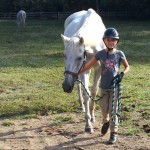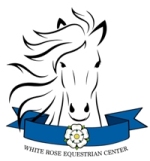Correctly Handling Horses
Precaution and common sense should be the key elements whenever you are approaching and handling horses. They are living creatures with a mind and will of their own and should be treated with a firm yet respectful hand. Take care when handling horses in order to keep you, other people, and the horse safe, and to prevent accidents. Consistency also helps the horse to understand his role in the relationship and behave appropriately.
Horses have been domesticated for many years but they still rely on their natural instincts to stay safe. If they feel threatened they will try to run away or, if cornered, can kick or bite to protect themselves. Whenever you are around horses you should be calm, move slowly, and speak softly. Loud or sudden movements or unexpected noise could startle them. Different surroundings or experiences can also cause a horse to become nervous. If this happens pat and stroke him gently and speak calmly and reassuringly to him.
Whenever possible, approach a horse towards his shoulder rather than straight towards his face or from behind. Due to the placement of the horse's eyes on the side of his head, he has a good all-around vision but does have a blind spot directly in front and behind. Let him know that you mean him no harm by walking slowly and talking to him in gentle tones. If he will let you, stroke his neck or shoulder rather than his face or nose.
If he is tied up and must be approached from behind, let him know you are there by talking to him before you approach. Although he can see behind him he does have a blind spot directly behind his rump. NEVER approach a horse directly from behind without first talking to him as he might be snoozing. If you startle him he could kick out in defense. Once he hears you and turns his head and can see you it is usually safe to approach him. Be vigilant and calm at all times.
Some Basic Rule For Correctly Handling Horses
- do not run, shout, or make loud noises around horses
- remember that some things that we take for granted might seem scary to a horse if he hasn't encountered them before. These can be anything from dogs, chickens, and other unfamiliar animals to balls, children's toys, or items blowing in the wind, etc.
- pay attention to where your horse puts his feet. He might accidentally step on your foot and not even realize. You should ALWAYS wear strong, sturdy footwear at the barn and never approach a horse in sandals, flip-flops, or bare feet.
- avoid being around the rear of a horse unless you are working on him i.e. grooming, picking out his feet, applying a tail bandage, etc. If you have to be behind a horse use caution and keep one hand on him at all times. If he moves quickly you will not only see this movement but also feel it and be able to act accordingly.
- have BOTH feet on the ground at all times (sometime this rule may have to be broken if you are braiding the mane of a tall horse, more about that later). Do not sit or kneel on the ground near a horse as that would make it too difficult to get out of harm's way should the need arise.
- do not take food into a field full of horses even if you have a horse who is difficult to catch. If you are surrounded by a group of horses all trying to get to the food you are in a very dangerous position.
- when you are handling horses around other people you need to also be aware of their actions and behavior. Politely show them how to behave and act in order to keep everyone safe.
How to Catch a Horse
Some horses are easier to catch than others and some are almost impossible to catch. For the purpose of this explanation, we will assume that the horse is reasonably easy to catch. (We will cover in a later blog series how to retrain a horse that is difficult to catch). One way to avoid ending up with a horse that is difficult to catch is to ensure that you catch your horse for reasons other than work. Catch him, from time to time, just to groom him or give him a treat and he will be far more likely to come to you in the field.

Enter the field calmly but with purpose. Walk towards your horse's shoulder, rather than his face or hindquarters, and call his name softly. Make sure that he has seen you, then walk up and slip the lead rope around his neck. Pat him gently on the neck or shoulder. With the lead rope still around his neck, carefully put on his halter (see next paragraph). Lead him out of the field making sure to avoid any of the other horses that are in there with him. If there are horses gathered around the gate area use a stern but quiet voice and, if necessary, hand gestures to make them move. Do not lead a horse through a group of other horses as this would put you in a dangerous position. Open the gate wide enough for both of you to get through safely but not wide enough that any other horses could escape. You might want to take someone with you to hold the gate until you feel comfortable doing this alone.
How to Put on A Halter
If a horse is loose in a stall or a field you will need to catch him and put on his halter. To halter a horse stand close to his left shoulder, facing forward. Loosely loop the lead rope around his neck to keep him still. Some halters have a buckle and some have a clasp, therefore, fitting them will be slightly different depending on which kind you are using.
Using a Halter With a Buckle
Standing near the horse's left shoulder and facing forwards, hold the halter buckle in your left hand and the crown-piece (strap) in your right hand. Reach under his neck with your right hand and guide his nose carefully into the noseband. Pass the crown-piece over the top of his poll and attach it to the buckle on his left cheek.
Using a Halter With a Clasp
Standing near the horse's left shoulder and facing forwards, make sure the clasp is open on the halter. Guide his nose into the noseband and gently lift the crown-piece over his ears, one at a time. Reach under his chin for the clasp and attach it to the ring on the left side of his cheek.
How to Lead and Turn a Horse at Walk and Trot Up In Hand
You should always use a halter and lead rope to lead a horse unless he is bridled. Never lead him by holding onto the halter. If something goes wrong and you let go he could run off and endanger himself or others or he could drag you off balance causing you injury.
A horse should be accustomed to being led from either side but the most accepted way to lead a horse is from the left (near side). The lead rope should be attached to the center 'O' ring under the horse's jaw. Hold the lead rope, in your right hand, close to the ring but DO NOT put your hand on the ring or your finger through it. Hold the remaining lead rope folded in your left hand. DO NOT wrap any of the lead rope around any parts of your body.
Ask your horse to walk on by standing near his left shoulder facing the direction you wish to go. Say 'walk on' and start to move. Most horses will oblige and start to walk. If he does not walk do not be tempted to get ahead of him or start pulling on his head. Carry a crop in your left hand and, reaching back behind you, tap him gently on this flanks. If you don't have a crop with you, you can use the loose end of the lead rope. You should continue to look ahead and remain next to his shoulder. Once he starts to walk make sure that your right arm is outstretched so as to keep him at arm's length preventing him from stepping on you by accident.
To turn a horse you are leading, whenever possible, turn him away from you. Steady him by putting a little pressure on the halter by pulling very slightly on the lead rope. Move your right arm further away from you and move him to the right. Stay at his shoulder. By turning him this way he is more likely to stay in balance than if you pulled him towards you. He is also less likely to step on you as he turns.
To make him trot do the same as you did to make him walk. Stay next to his shoulder, say 'trot on' and start to jog. If he does not move into the trot use the crop behind your back with a gentle tap on his flanks. The lead rope should be slack enough to allow him to carry the weight of his head naturally but not so slack that he, or you, might get your legs caught up in it.
Leading and trotting a horse up in hand, along with standing a horse up (see next section) is usually done without a saddle for either a veterinary inspection, for someone considering buying the horse, or for a judge at a show. The horse should be able to move freely and confidently but not hurried or unbalanced. If you need to lead a horse in an unfamiliar setting it would be best to put him in a bridle, instead of a halter, which would give you more control. It is usual to walk a horse away from the person inspecting it and then directly back towards them. They should move out of your way allowing you to pass by them. They will then usually ask you to do the same in trot.
How to Stand a Horse Up Correctly
The term standing a horse up simply means he is standing still, looking attentive, and showing his conformation to the best advantage. He should stand square. This means his front legs and back legs should be next to each other with his weight evenly distributed between all four legs. If he isn't standing squarely move him forwards slightly and stop again until he is. You should stand in front of him facing his head so that you don't obstruct the view of the person looking at him. If he is wearing a halter place one hand on each side of the noseband with the end of the lead rope in your left hand. If he is bridled hold one rein in each hand near to the bit. Raise your elbows slightly so that he doesn't try to nibble your wrists.
How to Hold a Reasonably Quiet Horse for Treatment, Shoeing, or Clipping
No matter how often your horse has been tied and expected to remain in one place there may come a time when you have to hold him for some reason. Whatever the reason, the most important thing is that you and the horse are both secure and safe.
Holding a Horse for Treatment
If your horse needs to be treated by a vet, the best thing to do is to listen carefully and follow their instructions. However, you know your horse and you might want to suggest that they treat him either in the stable or out of the stable depending on whichever he prefers. If you think he might be difficult to control it would be best to put him in a bridle instead of a halter. Do not tie him up. If you are using a halter and lead rope you could thread the lead rope through the Equi-Ping™ or breakable string but do not tie it, not even with a quick release knot. Your horse will probably think he is tied up but it still gives you the freedom to act should a difficult situation arise. Stand on the same side as the vet, unless they tell you otherwise. Do not, however, get in their way. When the vet has finished the treatment listen carefully to their instructions and be sure to follow them exactly. If they are complicated, write them down.
Holding a Horse for Shoeing
The same as above would apply but it will not always be possible to stand on the same side as the farrier as you might get in his way. If necessary, stand facing the horse as you would when standing him up.
Holding a Horse for Clipping
The same as above. Listen to the person doing the clipping and do as they ask.
How to Tie a Horse Up
The best way to secure a horse is either with a halter and lead rope or with a halter and cross ties. NEVER tie a horse up with a bridle. It is an expensive piece of tack to replace if broken. It can also result in a broken jaw of you tie up to the bit and the horse pulls away suddenly.
Tying Up to a Single Securing Ring
The lead rope should be fastened to the 'O' ring at the back of the noseband. Always use a quick release knot and NEVER tie directly onto the securing ring but instead use an Equi-Ping™ or breakable string (bailing twine works well for this). Although the reason for tying up the horse is to secure him in one place, it is very dangerous if he tries to break free and cannot. He could seriously injure himself in any struggle that might ensue. It is better for him to break loose.
Unless the horse is very trustworthy only tie him up in a stable or another enclosed place. Never tie him to an unsafe object such as a loose fence or thin branch on a tree. The securing ring should be placed high enough so that he cannot get his legs caught over the lead rope. Never tie him to a hay net. (Do not tie the hay net to the breakable string, it should be tied directly to the securing ring). If the horse tends to chew the lead rope either soak it in an unpalatable (but not poisonous) substance or use a chain. If you use a chain the breakable string should be between the chain and the halter not on the securing ring. You wouldn't want your horse to break loose and drag a chain along with him.
Cross-Tying
Cross-tying is very popular in America and is a means of tying a horse with two lead ropes or chains rather than just one. The horse is positioned between two walls or strong posts about 6 ½ feet apart, with the ropes or chains fastened to the Ds on each side of the halter. In barns where this kind of tying up is common practice, the cross-ties are permanent fixtures. They should always have some kind of Tie Safe™ or quick release mechanism attached to them. Do not use them if they don't. They are often used in grooming or wash stalls as they do not allow the horse to move as much thereby giving you more control. They should always be used if you are transporting a horse in a double trailer without the center partition.
How to Turn a Horse Out in a Field
When you are ready to turn your horse out into the field lead him there in either a halter or bridle. Usher away any horses that might be standing at the gate. Open the gate wide enough for you both to pass through safely. Make sure you close and latch the gate behind you. Walk him a little way into the field and turn around to face the gate. By doing this he will have to turn around before he can run into the field to join the other horses. If you let him go while he is facing into the field he could run over you by mistake in his haste to join his friends. If there is more than one of you turning horses out, make sure you all let go of them at the same time. If you do not follow this simple rule you could be dragged along if your horse tries to run off before you have let him go.
Whenever you are around or handling horses safety is of the utmost importance. By following the rules above you should be able to enjoy your time at the barn and around horses and ponies.
Previous Blog - Identifying Horses
Next Blog - Grooming a Horse
The content of this blog is copyrighted ©. It may not be reproduced in print or electronically without the written permission of White Rose Equestrian Center. It may be shared socially if linked back to this website. For more information contact us.
Disclaimer: We do not warranty any of these companies or products. These are items we use/have used and find them suitable for our needs. You should research these products before purchasing them. We are not sponsored by any of the aforementioned companies or products. These products have been bought by us for our own use. The links are affiliate links.
Follow our every move and keep up-to-date with tips, advice, and events, etc. |
|||
 |
 |
 |
 |

Pingback:
Identifying Horses - White Rose Equestrian Center Blog
Pingback:
Stable Management Knowledge and Care of Horses
Pingback:
Grooming a Horse - White Rose Equestrian Blog